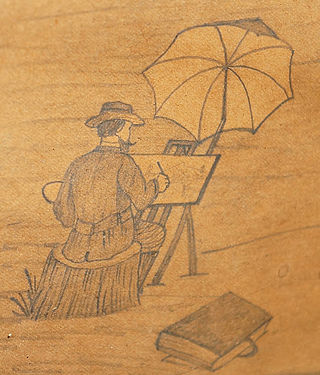Related Research Articles

Earl Township is a township in northeastern Lancaster County, Pennsylvania, United States. The population was 7,149 at the 2020 census.

Fraktur is a highly artistic and elaborate illuminated folk art created by the Pennsylvania Dutch, named after the Fraktur script associated with it. Most Fraktur were created between 1740 and 1860.

Ferdinand Arnold Brader is known for his large detailed pencil drawings of farms and other dwellings in rural Pennsylvania and Ohio.
Anna Weber (1814–1888) was a Canadian Mennonite Fraktur artist.
Jacob Strickler was an American fraktur artist.
Daniel Schumacher was an American fraktur painter. He was the first artist to use fraktur as a method of general record-keeping, rather than a document of important events.
Francis Charles Portzline was an American fraktur artist of German birth.

Johann Jacob Friedrich Krebs, commonly known as Friedrich Krebs was an American fraktur artist. He was the most prolific of the Pennsylvania German fraktur artists.

Johann HenrichOtto was an American fraktur artist.
Daniel Otto was an American fraktur artist.
Christian Mertel was an American fraktur artist.
Johannes ErnstSpangenberg (1755–1814) was an American fraktur artist.
Johann Christian Strenge was an American fraktur artist.
Samuel Bentz (1792–1850) was an American fraktur artist.

Martin Brechall was an American fraktur artist.

Johann Adam Eyer (1755–1837) was an American fraktur artist.
Johann Conrad Gilbert (1734–1812) was an American fraktur artist.
Samuel Gottschall (1800–1898) was an American fraktur artist.

The Sussel-Washington Artist was an American fraktur artist active during the 1770s and 1780s.

Jacob Maentel or Mental (1763–1863) was a German-American folk artist known for his portrayal of 19th-Century America. Maentel is most notable for his watercolor portrait art that minutely portrayed the décor and dress of early American immigrant communities.
References
- ↑ Gerard C. Wertkin (2 August 2004). Encyclopedia of American Folk Art . Routledge. ISBN 978-1-135-95614-1.
- ↑ "Philadelphia Museum of Art - Collections : Search Collections". www.philamuseum.org. Retrieved Apr 4, 2019.